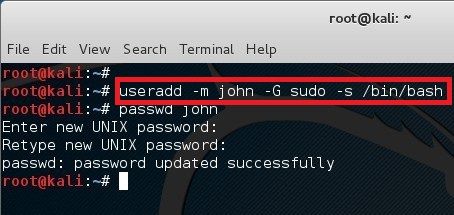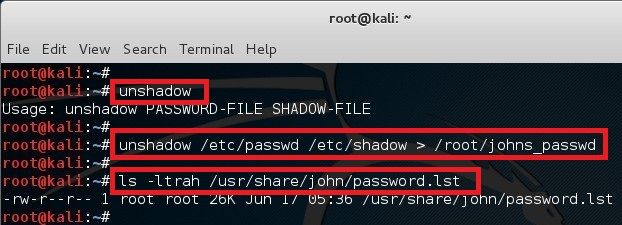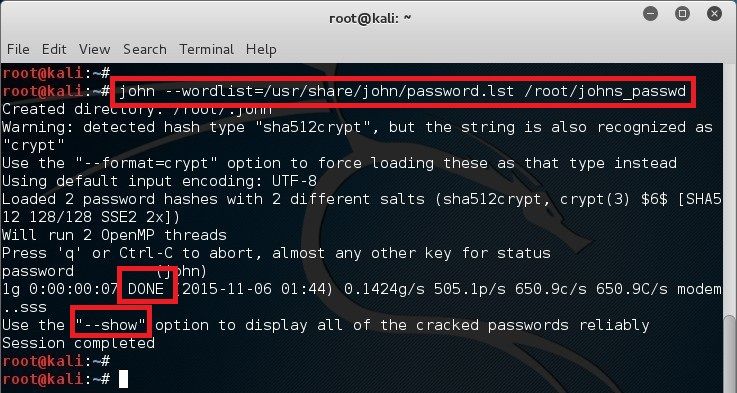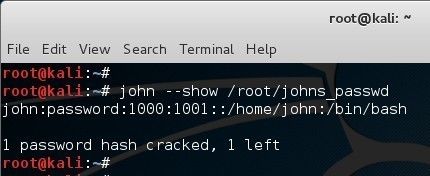John the Ripper is different from tools like Hydra. Hydra does blind brute-forcing by trying username/password combinations on a service daemon like ftp server or telnet server. John however needs the hash first. So the greater challenge for a hacker is to first get the hash that is to be cracked. Now a days hashes are more easily crackable using free rainbow tables available online. Just go to one of the sites, submit the hash and if the hash is made of a common word, then the site would show the word almost instantly. Rainbow tables basically store common words and their hashes in a large database. Larger the database, more the words covered.
One of the modes John the Ripper can use is the dictionary attack. It takes text string samples (usually from a file, called a wordlist, containing words found in a dictionary or real passwords cracked before), encrypting it in the same format as the password being examined (including both the encryption algorithm and key), and comparing the output to the encrypted string. It can also perform a variety of alterations to the dictionary words and try these. Many of these alterations are also used in John’s single attack mode, which modifies an associated plaintext (such as a username with an encrypted password) and checks the variations against the hashes.
John also offers a brute force mode. In this type of attack, the program goes through all the possible plaintexts, hashing each one and then comparing it to the input hash. John uses character frequency tables to try plaintexts containing more frequently used characters first. This method is useful for cracking passwords which do not appear in dictionary wordlists, but it takes a long time to run.
John the Ripper uses a 2 step process to cracking a password. First it will use the passwd and shadow file to create an output file. Next, you then actually use dictionary attack against that file to crack it. In short, John the Ripper will use the following two files:
/etc/passwd /etc/shadow
Cracking password using John the Ripper

In Linux, password hash is stored in /etc/shadow file. For the sake of this exercise, I will create a new user names john and assign a simple password ‘password’ to him.
I will also add john to sudo group, assign /bin/bash as his shell. There’s a nice article I posted last year which explains user creating in Linux in great details. It’s a good read if you are interested to know and understand the flags and this same structure can be used to almost any Linux/Unix/Solaris operating system. Also, when you create a user, you need their home directories created, so yes, go through creating user in Linux post if you have any doubts. Now, that’s enough mambo jumbo, let’s get to business.
First let’s create a user named john and assign password as his password. (very secured..yeah!)
root@kali:~# useradd -m john -G sudo -s /bin/bash root@kali:~# passwd john Enter new UNIX password: <password> Retype new UNIX password: <password> passwd: password updated successfully root@kali:~#
Unshadowing password
Now that we have created our victim, let’s start with unshadow commands.
The
unshadow command will combine the extries of /etc/passwd and
/etc/shadow to create 1 file with username and password details. When
you just type in unshadow, it shows you the usage anyway.I’ve redirected the output to /root/johns_passwd file because I got the ticks for organizing things. Do what you feel like here.root@kali:~# unshadow Usage: unshadow PASSWORD-FILE SHADOW-FILE root@kali:~# unshadow /etc/passwd /etc/shadow > /root/johns_passwd
Cracking process with John the Ripper
At this point we just need a dictionary file and get on with cracking. John comes with it’s own small password file and it can be located in /usr/share/john/password.lst. I’ve showed the size of that file using the following command.You can use your own password lists too or download a large one from Internet (there’s lots of dictionary file in terabyte size).root@kali:~# ls -ltrah /usr/share/john/password.lst
root@kali:~# john --wordlist=/usr/share/john/password.lst /root/johns_passwd Created directory: /root/.john Warning: detected hash type "sha512crypt", but the string is also recognized as "crypt" Use the "--format=crypt" option to force loading these as that type instead Using default input encoding: UTF-8 Loaded 2 password hashes with 2 different salts (sha512crypt, crypt(3) $6$ [SHA512 128/128 SSE2 2x]) Will run 2 OpenMP threads Press 'q' or Ctrl-C to abort, almost any other key for status password (john) 1g 0:00:00:06 DONE (2015-11-06 13:30) 0.1610g/s 571.0p/s 735.9c/s 735.9C/s modem..sss Use the "--show" option to display all of the cracked passwords reliably Session completed root@kali:~#
Looks like it worked. So we can now use john –show option to list cracked passwords. Note that it’s a simple password that existed in the dictionary so it worked. If it wasn’t a simple password, then you would need a much bigger dictionary and lot longer to to crack it.
root@kali:~# john --show /root/johns_passwd john:password:1000:1001::/home/john:/bin/bash 1 password hash cracked, 1 left root@kali:~#
John the Ripper advanced commands:
Now that we have completed the basics of John the Ripper and cracked a password using it, it’s possibly time to move on to bigger and more complex things. For that you should check the documentation on cracking MODES and examples of John the Ripper usage.
blackmoreops




Không có nhận xét nào:
Đăng nhận xét